List of plants used in herbalism(1)
List of plants used in herbalism
This is a list of plants used or formerly used as herbal medicine.
The ability to synthesize a wide variety of chemical compounds that are used to perform important biological functions, and to defend against attack from predators such as insects, fungi and herbivorous mammals is called herbal medicine. Many of these phytochemicalshave beneficial effects on long-term health when consumed by humans, and can be used to effectively treat human diseases. At least 12,000 such compounds have been isolated so far; a number estimated to be less than 10% of the total.[1][2]
These phytochemicals are divided into (1) primary metabolites such as sugars and fats, which are found in all plants; and (2) secondary metabolites – compounds which are found in a smaller range of plants, serving a more specific function.[3] For example, some secondary metabolites are toxins used to deter predation and others are pheromones used to attract insects for pollination. It is these secondary metabolites and pigments that can have therapeutic actions in humans and which can be refined to produce drugs—examples are inulinfrom the roots of dahlias, quinine from the cinchona, morphine and codeine from the poppy, and digoxin from the foxglove.[3]
Chemical compounds in plants mediate their effects on the human body through processes identical to those already well understood for the chemical compounds in conventional drugs; thus herbal medicines do not differ greatly from conventional drugs in terms of how they work. This enables herbal medicines to be as effective as conventional medicines, but also gives them the same potential to cause harmful side effects.[1][2]
In Europe, apothecaries stocked herbal ingredients for their medicines. In the Latin names for plants created by Linnaeus, the word officinalis indicates that a plant was used in this way. For example, the marsh mallow has the classification Althaea officinalis, as it was traditionally used as an emollient to soothe ulcers.[4] Ayurvedic medicine, herbal medicine and traditional Chinese medicine are other examples of medical practices that incorporate medical uses of plants. Pharmacognosy is the branch of modern medicine about medicines from plant sources. Plants included here are those that have been or are being used medicinally, in at least one such medicinal tradition.
Modern medicine now tends to use the active ingredients of plants rather than the whole plants. The phytochemicals may be synthesized, compounded or otherwise transformed to make pharmaceuticals. Examples of such derivatives include digoxin, from digitalis; capsaicine, from chili; and aspirin, which is chemically related to the salicylic acid found in white willow. The opium poppy continues to be a major industrial source of opiates, including morphine. Few traditional remedies, however, have translated into modern drugs, although there is continuing research into the efficacy and possible adaptation of traditional herbal treatments.
A[edit]
| Scientific name | Name | Description | Picture |
|---|---|---|---|
| Acacia senegal | Gum arabic |  | |
| Achillea millefolium | Common yarrow | Purported to be a diaphoretic, astringent,[5] tonic, stimulant and mild aromatic. |  |
| Actaea racemosa | Black cohosh | Historically used for arthritis and muscle pain, used more recently for conditions related to menopause and menstruation.[6] |  |
| Aesculus hippocastanum | Horse chestnut | Its seeds, leaves, bark, and flowers have been used medicinally for many centuries. The raw plant materials are toxic unless processed.[7] | 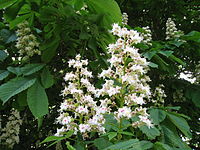 |
| Ageratina altissima | White snakeroot | Root tea has been used to treat diarrhea, kidney stones, and fever. A root poultice can be used on snakebites.[8] | 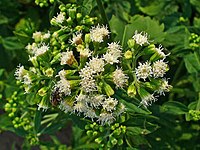 |
| Alcea rosea | Common hollyhock | Believed to be an emollient and laxative. It is used to control inflammation, to stop bedwetting and as a mouthwash in cases of bleeding gums.[9] |  |
| Alisma plantago-aquatica | Water-plantain | Used for the urinary tract.[10] | 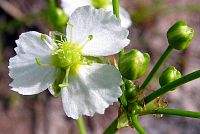 |
| Allium sativum | Garlic | Widely used as an antibiotic[11][12][13][14] and, more recently, for treating cardiovascular disease[15][16] Garlic is a monoamine oxidase inhibitor and has antidepressant-like effects on mice[17] so might be used as a herbal antidepressant or anxiolytic in humans.[18] |  |
| Aloe vera | Aloe vera | Leaves are widely used to heal burns, wounds and other skin ailments.[19][20] | 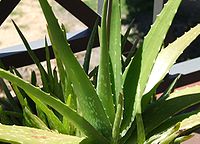 |
| Althaea officinalis | Marsh-mallow | Used for over 2,000 years as both a food and a medicine[4] | 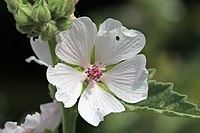 |
| Amorphophallus konjac | Konjac | Significant dietary source of glucomannan,[21][22] which is used in treating obesity,[23] constipation,[24] and reducing cholesterol.[25] | 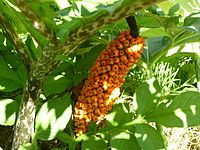 |
| Anemone hepatica | Common hepatica | Historically used to treat liver diseases, it is still used in alternative medicine today. Other modern applications by herbalists include treatments for pimples, bronchitis and gout.[26] | 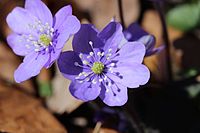 |
| Angelica archangelica | Garden angelica | Roots have been used in the traditional Austrian medicine internally as tea or tincture for treatment of disorders of the gastrointestinal tract, respiratory tract, nervous system, and also against fever, infections, and flu.[27] | 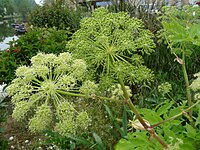 |
| Angelica sinensis | Dong quai | Used for thousands of years in Asia, primarily in women's health.[28] | |
| Apium graveolens | Celery | Seed is used only occasionally in tradition medicine. Modern usage is primarily as a diuretic.[29] | 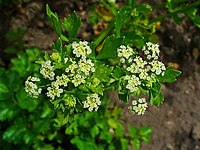 |
| Arctium lappa | Burdock | Used traditionally as a diuretic and to lower blood sugar[30] and, in traditional Chinese medicine as a treatment for sore throat and symptoms of the common cold.[31] |  |
| Arnica montana | Arnica | Used as an anti-inflammatory[32] and for osteoarthritis.[33] The US Food and Drug Administration has classified Arnica montana as an unsafe herb because of its toxicity.[34] It should not be taken orally or applied to broken skin where absorption can occur.[34] | 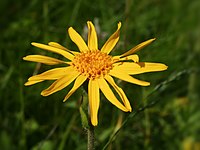 |
| Astragalus propinquus | Astragalus | Long been used in traditional Chinese medicine to strengthen the immune system, and is used in modern China to treat hepatitis and as an adjunctive therapy in cancer.[35] | 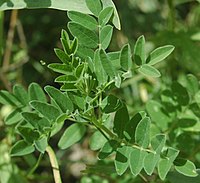 |
| Atropa belladonna | Belladonna | Although toxic, was used historically in Italy by women to enlarge their pupils, as well as a sedative, among other uses. The name itself means "beautiful woman" in Italian.[36] | 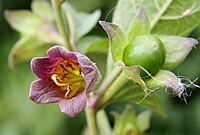 |
| Azadirachta indica | Neem | Used in India to treat worms, malaria, rheumatism and skin infections among many other things. Its many uses have led to neem being called "the village dispensary" in India.[37] | 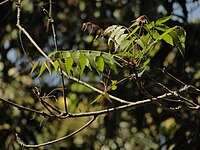 |
B[edit]
| Scientific name | Name | Description | Picture |
|---|---|---|---|
| Bellis perennis | Daisy | Flowers have been used in the traditional Austrian medicine internally as tea (or the leaves as a salad) for treatment of disorders of the gastrointestinal and respiratory tract.[38] | 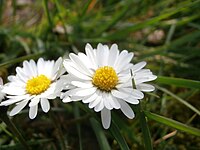 |
| Berberis vulgaris | Barberry | Long history of medicinal use, dating back to the Middle Agesparticularly among Native Americans. Uses have included skin ailments, scurvy and gastro-intestinal ailments.[39] |  |
| Borago officinalis | Borage | Used in hyperactive gastrointestinal, respiratory and cardiovascular disorders,[40] such as gastrointestinal (colic, cramps, diarrhea), airways (asthma, bronchitis), cardiovascular, (cardiotonic, antihypertensive and blood purifier), urinary (diuretic and kidney/bladder disorders).[41] | 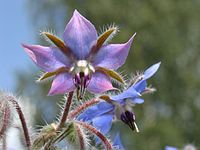 |
| Broussonetia kurzii | Salae | Known as Salae in Thailand where this species is valued as a medicinal plant.[42] |
C[edit]
| Scientific name | Name | Description | Picture |
|---|---|---|---|
| Calendula officinalis | Marigold | Also named calendula, has a long history of use in treating wounds and soothing skin[43] | 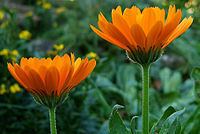 |
| Capsicum annuum | Cayenne | Type of chili that has been used as both food and medicine for thousands of years. Uses have included reducing pain and swelling, lowering triglyceride and cholesterol levels and fighting viruses and harmful bacteria, due to high levels of Vitamin C.[44][45][46] | 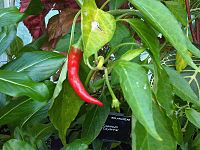 |
| Capsicum frutescens | Chili | Its active ingredient, capsaicine, is the basic of commercial pain-relief ointments in Western medicine. The low incidence of heart attack in Thais may be related to capsaicine's fibronolytic action(dissolving blood clots).[47] |  |
| Carica papaya | Papaya | Used for treating wounds.[48] | 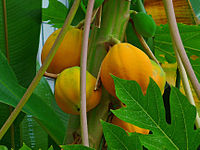 |
| Cassia occidentalis | Coffee senna | Used in a wide variety of roles in traditional medicine, including in particular as a broad-spectrum internal and external antimicrobial, for liver disorders, for intestinal worms and other parasites and as an immune-system stimulant.[49][50] |  |
| Catha edulis | Khat | Mild stimulant used for thousands of years in Yemen, and is banned today in many countries. Contains the amphetamine-like substance cathinone. | 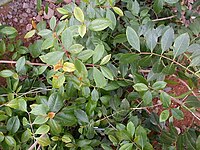 |
| Cayaponia espelina | São Caetano melon | It is a diuretic and aid in the treatment of diarrhea and syphilis.[51] | 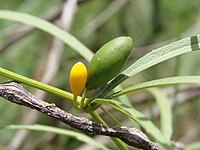 |
| Centaurea cyanus | Cornflower | In herbalism, a decoction of cornflower is effective in treating conjunctivitis and as a wash for tired eyes.[52] | 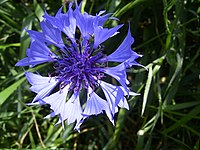 |
| Chrysopogon zizanioides | Vetiver | Used for skin care.[53] | 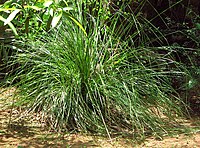 |
| Cinchona spec. | Cinchona | Genus of about 38 species of trees whose bark is a source of alkaloids, including quinine. Its use as a febrifuge was first popularized in the 17th century by Peruvian Jesuits.[54] |  |
| Citrus × aurantium | Bitter orange | Used in traditional Chinese medicine and by indigenous peoples of the Amazon for nausea, indigestion and constipation.[55] |  |
| Citrus limon | Lemon | Along with other citruses, it has a long history of use in Chineseand Indian traditional medicine.[56] In contemporary use, honey and lemon is common for treating coughs and sore throat. |  |
| Citrus trifoliata | Trifoliate orange, bitter orange | Fruits of Citrus trifoliata are widely used in Oriental medicine as a treatment for allergic inflammation.[57] |  |
| Cissampelos pareira | Velvetleaf | Used for a wide variety of conditions.[58] |  |
| Cnicus benedictus | Blessed thistle | Used during the Middle Ages to treat bubonic plague. In modern times, herbal teas made from blessed thistle are used for loss of appetite, indigestion and other purposes.[59] | 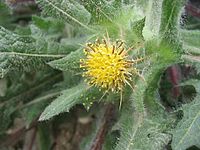 |
| Crataegus monogyna and Crataegus laevigata | Hawthorn | Fruit has been used for centuries for heart disease. Other uses include digestive and kidney related problems.[60] |  |
| Curcuma longa | Turmeric | Spice that lends its distinctive yellow color to Indian curries, has long been used in Ayurvedic and traditional Chinese medicine to aid digestion and liver function, relieve arthritis pain, and regulate menstruation.[61] | 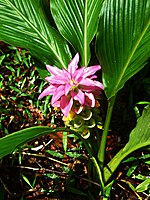 |
| Cypripedium parviflorum | Yellow lady's slipper | The Cypripedium species have been used in native remedies for dermatitis, tooth aches, anxiety, headaches, as an antispasmodic, stimulant and sedative. However, the preferred species for use are Cyp. parviflorum and Cyp.acaule, used as topical applications or tea.[62][63] | 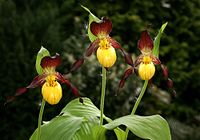 |
D[edit]
| Scientific name | Name | Description | Picture |
|---|---|---|---|
| Digitalis lanata | Digitalis or foxglove | It came into use in treating cardiac disease in late 18th century England in spite of its high toxicity.a Its use has been almost entirely replaced by the pharmaceutical derivative Digoxin, which has a shorter half-life in the body, and whose toxicity is therefore more easily managed.[64] Digoxin is used as an antiarrhythmic agent and inotrope.[65] |  |
E[edit]
| Scientific name | Name | Description | Picture |
|---|---|---|---|
| Echinacea purpurea | Purple coneflower | This plant and other species of Echinacea have been used for at least 400 years by Native Americans to treat infections and wounds, and as a general "cure-all" (panacea). It is currently used for symptoms associated with cold and flu[66][67] | 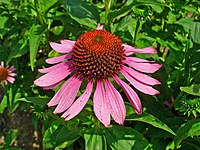 |
| Equisetum arvense | Horsetail | Dates back to ancient Roman and Greek medicine, when it was used to stop bleeding, heal ulcers and wounds, and treat tuberculosis and kidney problems.[68] |  |
| Eriodictyon crassifolium | Yerba Santa | Used by the Chumash people to keep airways open for proper breathing.[69] | 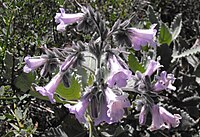 |
| Eschscholzia californica | Californian poppy | Used as an herbal remedy: an aqueous extract of the plant has sedative and anxiolytic actions.[70] | 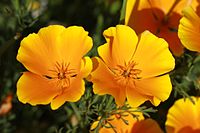 |
| Eucalyptus globulus | Eucalyptus | Leaves were widely used in traditional medicine as a febrifuge.[71]Eucalyptus oil is commonly used in over-the-counter cough and cold medications, as well as for an analgesic.[72] |  |
| Euonymus atropurpureus | Wahoo | Plant is a purgative and might affect the heart.[73] | |
| Euphorbia hirta | Asthma-plant | Used traditionally in Asia to treat bronchitic asthma and laryngeal spasm.[74][75] It is used in the Philippines for dengue fever.[76] |  |
| Euterpe oleracea | Açai | Although açai berries are a longstanding food source for indigenous people of the Amazon, there is no evidence that they have historically served a medicinal, as opposed to nutritional role. In spite of their recent popularity in the United States as a dietary supplement, there is currently no evidence for their effectiveness for any health-related purpose.[77] |
F[edit]
| Scientific name | Name | Description | Picture |
|---|---|---|---|
| Ferula assa-foetida | Asafoetida | Might be useful for IBS, high cholesterol, and breathing problems.[78] | |
| Frangula alnus | Alder buckthorn | Bark (and to a lesser extent the fruit) has been used as a laxative, due to its 3 – 7% anthraquinone content. Bark for medicinal use is dried and stored for a year before use, as fresh bark is violently purgative; even dried bark can be dangerous if taken in excess.[79] |  |
| Fumaria officinalis | Fumitory | Traditionally thought to be good for the eyes and to remove skin blemishes. In modern times herbalists use it to treat skin diseasesand conjunctivitis, as well as to cleanse the kidneys. However, Howard (1987) warns that fumitory is poisonous and should only be used under the direction of a medical herbalist.[80] |  |
G[edit]
| Scientific name | Name | Description | Picture |
|---|---|---|---|
| Galanthus | Snowdrop | It contains an active substance called galantamine, which is an acetylcholinesterase inhibitor. Galantamine (or galanthamine) can be helpful in the treatment of Alzheimer's disease, though it is not a cure.[81] |  |
| Geranium robertianum | Robert geranium | In traditional herbalism, it was used as a remedy for toothache and nosebleeds[82] and as a vulnerary (used for or useful in healing wounds).[83] | 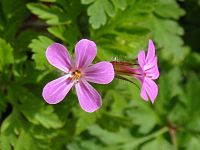 |
| Ginkgo biloba | Ginkgo | The leaf extract has been used to treat asthma, bronchitis, fatigue, Alzheimer's and tinnitus.[84] | 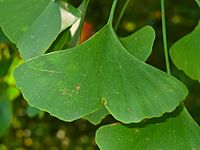 |
| Glechoma hederacea | Ground-ivy | It has been used as a "lung herb".[85] Other traditional uses include as an expectorant, astringent, and to treat bronchitis.[86] The essential oil of the plant has been used for centuries as a general tonic for colds and coughs, and to relieve congestion of the mucous membranes. | 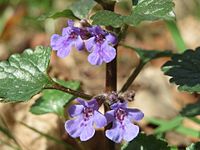 |
| Glycyrrhiza glabra | Licorice root | It has a long history of medicinal usage in Eastern and Western medicine. Uses include stomach ulcers, bronchitis, and sore throat, as well as infections caused by viruses, such as hepatitis.[87] |
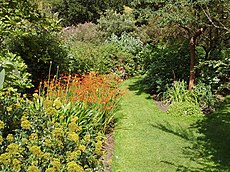
تعليقات
إرسال تعليق